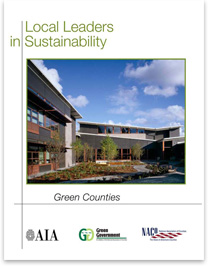|
AIA, National Association of Counties Issue “Local Leaders in Sustainability: Green Counties” Analysis
by Brooks Rainwater
Director, AIA Local Relations
 Summary: American counties are showing how to “Walk the Walk” on sustainability by creating impressive green building programs across the country. County green building programs have increased fivefold since 2003, and the future looks bright for green design, according to Local Leaders in Sustainability: Green Counties, an analysis conducted by the AIA and the National Association of Counties (NACo) of the current state of green building development in the 200 most populous U.S. counties, representing 168,864,538 Americans, or a little more than half of the country’s population. Summary: American counties are showing how to “Walk the Walk” on sustainability by creating impressive green building programs across the country. County green building programs have increased fivefold since 2003, and the future looks bright for green design, according to Local Leaders in Sustainability: Green Counties, an analysis conducted by the AIA and the National Association of Counties (NACo) of the current state of green building development in the 200 most populous U.S. counties, representing 168,864,538 Americans, or a little more than half of the country’s population.
This analysis provides a tool for communities (as well as other levels of government) that seek to create future green building programs. In conducting this study, the AIA spoke to planners, building officials, and sustainability managers across the country, resulting in a total response rate of 88 percent.
Key findings
The AIA and NACo discovered that among the top 200 county areas:
- 39 counties have a green building program, or at least 19.5 percent of all sample counties
- At least 42,949,498 people, or 25.6 percent of the sample population, live in counties with green building programs
- A further nine counties indicated that they are in a more advanced stage of developing green building programs, forecasting a future of increased green activity.
Regionally:
- The Eastern Region has the most green building programs at 19, covering approximately 19 million people
- The Central Region has 7 programs, with approximately 9 million people living in those counties with green building programs
- The Mountain Region was a smaller portion of the sample, with only 3 programs; more than 2 million people live in these counties
- The Western Region rounded out the survey with 10 green building programs and almost 13 million affected citizens.
Case studies, too
The report also includes a case study section to demonstrate the best practices and diversity of sustainability policy. Many of these programs have also been established for a number of years, providing the opportunity to see what works well and how needed adjustments were made. Alameda County, Calif.; Hennepin County, Minn.; King County, Wash.; and Montgomery County, Md., are included as solid best-practice programs that can be viewed as models. Another grouping of county governments across Florida, also featured, is now overcoming legal barriers to create a culture of sustainable development that represents the next wave of green building policy. The experiences of these counties make it increasingly clear that investment in high-performance building programs is an efficient and popular use of taxpayer dollars.
For more information, read the report on the AIA Government Advocacy Web site. |



